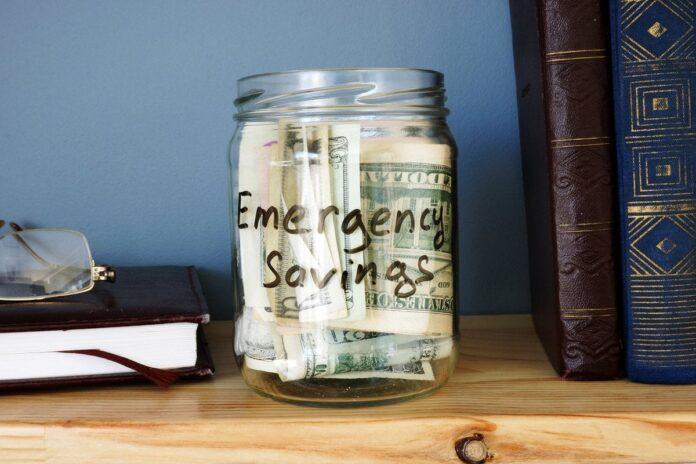LEARNING OBJECTIVES FROM THIS ARTICLE:
- What is an emergency fund and why do you need one?
- What are the benefits of having an emergency fund?
- How much should you save for an emergency fund?
- How can you build an emergency fund?
- When should you tap into your emergency fund?
Imagine going skydiving without a backup parachute…Terrifying idea, right? You are putting complete trust of your life in “plan A” and praying that nothing goes wrong. Well, going through life without an emergency fund is kind of like going skydiving without a backup parachute – you’re betting that everything in your financial life will always go as plan, all the time.
We know that nothing every goes as planned 100% of the time. Thankfully, we have backup parachutes for skydiving, and we have emergency funds for life’s financial scares, but even with the knowledge, many Americans still find themselves ill prepared to handle financial emergency. According to a survey conducted by the personal finance website Bankrate,
60% of Americans would not be able to pay an unexpected $1,000 emergency.
25% of U.S. adults say they have no emergency savings at all.
23% say they only have enough money to cover their bills for one to three weeks.
Our goal by the end of this article is to make sure you have the tools and knowledge necessary to avoid the common financial pitfall of not having an adequate emergency fund. By the time you finish reading this article you will know what an emergency fund is, why you need one, and how you can begin building your own fund TODAY!
What is an emergency fund and why do you need one?
An emergency fund is money you set aside for life’s unexpected events. These events tend to be urgent and costly. Some of the top emergencies people face include:
- The loss of a job
- Medical or dental expenses
- Unexpected home repairs
- Car trouble
Things that wouldn’t be considered emergencies include expenses such as vacations, a new car (because you no longer favor your current one), or any expense that isn’t a necessary living expense (i.e. mortgage/rent, food, transportation, bills).
The reason an emergency fund is a necessary component of creating financial stability is simple – stuff happens. Your emergency fund will come in handy if you suddenly lose your job or your car dies on you. Your emergency fund serves as your safety net in SHTF moments.
What are the benefits of having an emergency fund?
Along with serving as a financial safety net, having an emergency fund comes with many other enduring benefits such as:
An emergency fund will create financial stability in your life.
You will always have cash reserves ready in case of an emergency. No need to take out a loan or borrow money to pay your bills if an unexpected expense occurs – you got yourself covered.
An emergency fund will keep your stress level down.
Not having an adequate emergency fund can have you living on edge hoping that an emergency doesn’t come up. Just like having a spare tire in your car or first-aid kit at home provides peace-of-mind through preparedness, your emergency fund serves as your financial stress reliever. Practice financial self-care today by stashing away a few dollars away in an emergency fund.
An emergency fund will help you reach financial independence.
Having an adequate emergency fund allows you to better plan for the future by freeing up your bank account and mind to focus on wealth building rather than on just making it to your next paycheck.
How much should you save in an emergency fund?
Most financial advisers suggest building an emergency fund of 3 to 6 months of living expenses. Living expenses consist of all your essential needs such as: housing, food, utilities, insurance, transportation, debt payments. In general, saving enough to cover 3 to 6 months of living expenses will meet most worst-case scenarios ranging from a job lost, an unexpected medical bill, or a major expense such as a home or car replacement.
If you’re just starting to build an emergency fund, saving 3 to 6 months of living expenses can seem like a daunting task. A more realistic goal may be to start building a “starter” emergency fund of $1,000 and continue adding to this amount over time. This amount is enough to cover most emergencies and prevent you from falling behind on your bills. After you’ve established an emergency fund big enough to cover most unexpected events, you’ll want to continue contributing to your fund until you have 3 to 6 months of living expenses saved.
How do you build an emergency fund?
Building an emergency fund is easy – it just takes a little bit of time, patience, and fiscal discipline. Here are three steps you can take today to start building your fund:
Set a savings goal. Determine how much you want to save for your emergency fund and when you want to have this amount saved by. For example, if your goal is to build a $1,000 emergency fund in a year you would need to save ~$83.33 a month ($1000 ÷ 12 months). The formula below is a simple way to calculate how much you need to save a month to reach your goal.
savings goal amount ÷ number of months to reach goal =
amount you need to save monthly to reach your goal
Budget for your emergency fund. You will need to figure out what percentage or dollar amount of your income you need to save every month to reach your goal. This might mean that you need to cut back on your discretionary spending or that you need a side hustle to earn extra money to contribute to your fund on a consistent basis.
Automate your savings. The money budgeted to your emergency fund should be the first thing to come out of your paycheck every month after paying your bills to ensure that you’re consistently building it up. Personally, I like to keep my emergency fund in a separate savings/money market account (as of November 2020, Marcus by Goldman Sachs has the best interest rates and doesn’t require a minimum balance to open an account) that way I can earn interest on the money and still access it quickly in an emergency.
When should you use your emergency fund?
So, what constitutes an emergency anyway? Here are three simple questions to ask yourself to determine if you need to tap into your emergency savings:
- Is it unexpected?
- Is it necessary?
- Is it urgent?
If you find yourself answering yes to most of these questions, chances are the expense is a legit emergency and justifies the use of your emergency fund. If you answered no to one or two of these questions, then the expense may not really be an emergency and you can cover it using a rainy-day fund (a small account of $250-$500 for minor expenses) or paying out-of-pocket.
Conclusion
The road to financial independence is filled with many unexpected twists and turns, but if you’re prepared, what might spell financial disaster for many will only be a brief period of financial inconvenience for you. Remember, building your emergency fund won’t happen overnight, but by setting a monthly savings goal and making consistent contributions to it, you will build a financial foundation strong enough to weather any storm!















